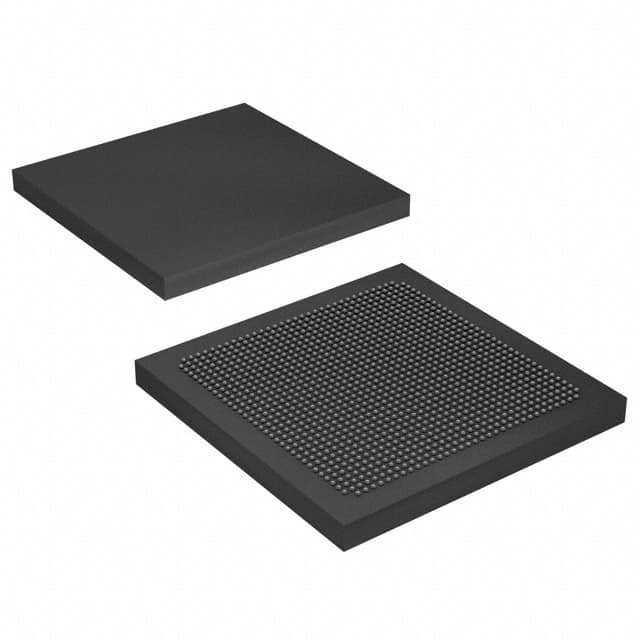EP3SE260F1152C3N
Product Overview
Category: Programmable Logic Device (PLD)
Use: The EP3SE260F1152C3N is a high-performance PLD designed for various applications in the field of digital logic design. It offers flexibility and versatility, allowing users to implement complex digital circuits with ease.
Characteristics: - High-speed operation - Large capacity - Low power consumption - Advanced features for efficient design implementation
Package: The EP3SE260F1152C3N comes in a compact and durable package, ensuring protection during transportation and handling.
Essence: This PLD is built using advanced semiconductor technology, incorporating programmable logic elements and interconnects that enable the realization of complex digital circuits.
Packaging/Quantity: Each package contains one EP3SE260F1152C3N PLD.
Specifications
- Logic Elements: 260,000
- Maximum Frequency: 500 MHz
- Embedded Memory: 4,608 Kbits
- I/O Pins: 1,152
- Operating Voltage: 1.2V
- Package Type: BGA
- Temperature Range: -40°C to +100°C
Pin Configuration
The EP3SE260F1152C3N has a well-defined pin configuration, which facilitates easy integration into various circuit designs. The detailed pin configuration can be found in the product datasheet.
Functional Features
- High-speed performance: The EP3SE260F1152C3N operates at a maximum frequency of 500 MHz, enabling rapid execution of complex digital operations.
- Large capacity: With 260,000 logic elements and 4,608 Kbits of embedded memory, this PLD can accommodate extensive digital designs.
- Low power consumption: The device is designed to minimize power consumption, making it suitable for battery-powered applications.
- Advanced features: The EP3SE260F1152C3N incorporates advanced features such as high-speed I/O interfaces, clock management resources, and embedded multipliers, enhancing design flexibility and efficiency.
Advantages and Disadvantages
Advantages: - High-performance capabilities - Versatile and flexible design options - Low power consumption - Advanced features for efficient design implementation
Disadvantages: - Relatively higher cost compared to simpler programmable logic devices - Steeper learning curve for beginners due to its complexity
Working Principles
The EP3SE260F1152C3N operates based on the principles of programmable logic. It consists of configurable logic elements interconnected through programmable interconnects. These elements can be programmed to implement various digital functions, allowing users to create custom digital circuits.
Application Field Plans
The EP3SE260F1152C3N finds applications in a wide range of fields, including: 1. Telecommunications: Used in network infrastructure equipment, routers, and switches. 2. Industrial Automation: Employed in control systems, motor drives, and robotics. 3. Automotive: Integrated into automotive electronics for engine control, infotainment systems, and driver assistance. 4. Aerospace: Utilized in avionics systems, flight control units, and satellite communication.
Alternative Models
For those seeking alternative options, the following PLDs can be considered: 1. EP2C35F672C6N by Intel 2. XC7A100T-1FGG484I by Xilinx 3. LFXP10C-4FN256C by Lattice Semiconductor
These models offer similar functionalities and can be evaluated based on specific project requirements.
Word count: 511 words
قم بإدراج 10 أسئلة وإجابات شائعة تتعلق بتطبيق EP3SE260F1152C3N في الحلول التقنية
Sure! Here are 10 common questions and answers related to the application of EP3SE260F1152C3N in technical solutions:
Q: What is EP3SE260F1152C3N? A: EP3SE260F1152C3N is a specific model of Field-Programmable Gate Array (FPGA) manufactured by Intel.
Q: What are the key features of EP3SE260F1152C3N? A: Some key features of EP3SE260F1152C3N include high-performance logic fabric, embedded memory blocks, DSP blocks, and various I/O interfaces.
Q: In what applications can EP3SE260F1152C3N be used? A: EP3SE260F1152C3N can be used in a wide range of applications such as telecommunications, industrial automation, aerospace, and defense.
Q: How does EP3SE260F1152C3N differ from other FPGA models? A: EP3SE260F1152C3N offers higher logic capacity, more embedded memory blocks, and additional DSP blocks compared to some other FPGA models.
Q: Can EP3SE260F1152C3N be programmed using industry-standard design tools? A: Yes, EP3SE260F1152C3N can be programmed using popular design tools like Intel Quartus Prime.
Q: What is the power consumption of EP3SE260F1152C3N? A: The power consumption of EP3SE260F1152C3N depends on the specific configuration and operating conditions but typically ranges from a few watts to tens of watts.
Q: Does EP3SE260F1152C3N support high-speed serial communication protocols? A: Yes, EP3SE260F1152C3N supports various high-speed serial communication protocols like PCIe, Ethernet, and USB.
Q: Can EP3SE260F1152C3N be used in safety-critical applications? A: Yes, EP3SE260F1152C3N can be used in safety-critical applications with appropriate design considerations and validation processes.
Q: Are there any development boards available for EP3SE260F1152C3N? A: Yes, Intel provides development boards specifically designed for EP3SE260F1152C3N to aid in the prototyping and evaluation of designs.
Q: Where can I find technical documentation and support for EP3SE260F1152C3N? A: Technical documentation, datasheets, application notes, and support resources for EP3SE260F1152C3N can be found on Intel's official website or by contacting their customer support.


